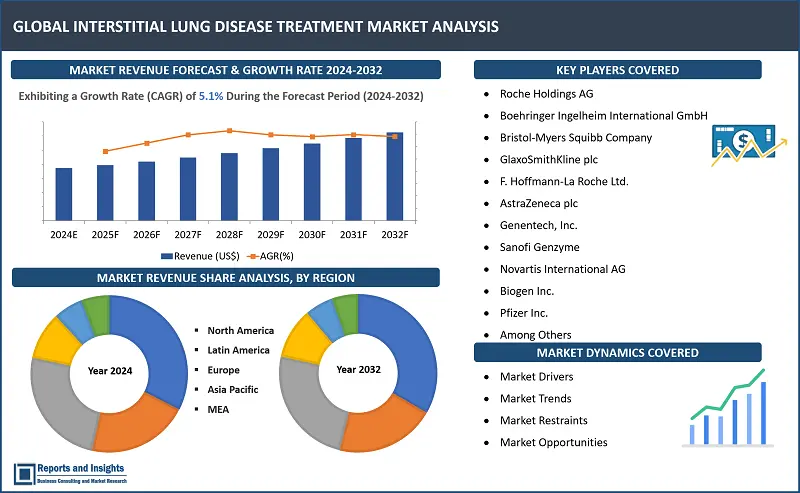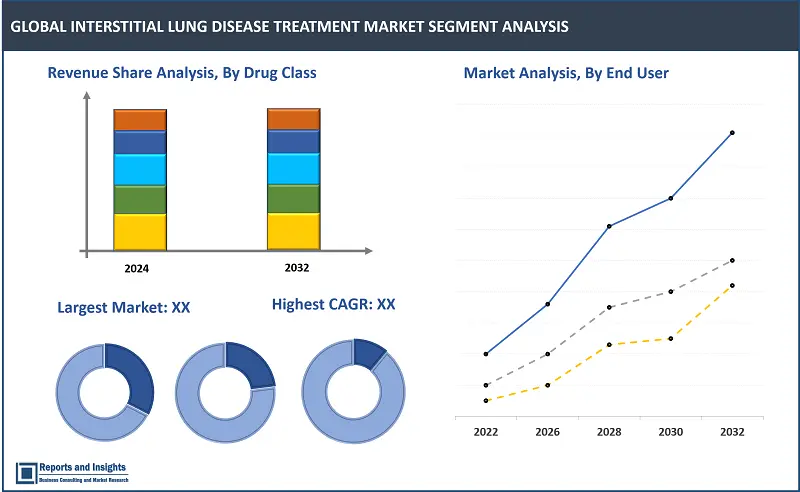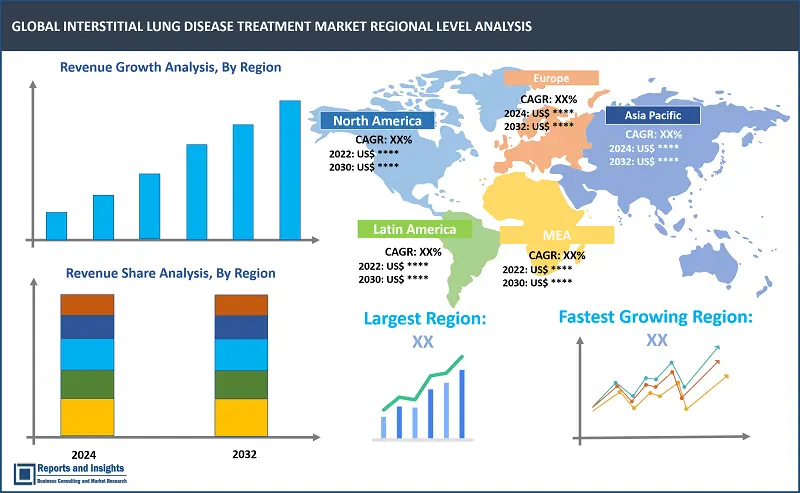Market Overview:
"The global interstitial lung disease treatment market size reached US$ 1.3 billion in 2023. Looking forward, Reports and Insights expects the market to reach US$ 2.0 billion in 2032, exhibiting a growth rate (CAGR) of 5.1% during 2024-2032."
|
Report Attributes |
Details |
|
Base Year |
2023 |
|
Forecast Years |
2024-2032 |
|
Historical Years |
2021-2023 |
|
Market Growth Rate (2024-2032) |
5.1% |
Interstitial Lung Disease (ILD) refers to a group of disorders that cause inflammation and scarring of the lung tissue. The most common form of interstitial lung disease is Idiopathic Pulmonary Fibrosis (IPF), and treatment depends on the specific type of ILD, its severity, and the underlying cause. Interstitial lung disease treatment encompasses a multifaceted approach aimed at mitigating the inflammation and scarring of lung tissue. ILD is initially treated with a corticosteroid (prednisone) and sometimes in combination with other drugs to suppress the immune system. Advanced treatment modalities include the use of corticosteroids, immunosuppressive drugs, antifibrotic medications, and pulmonary rehabilitation to address diverse ILD types, and lung transplants may be considered in severe cases.
Technological advancements have resulted in the development of antifibrotic drugs like Nintedanib, Treprostinil, and Pirfenidone, offering promising results in slowing disease progression. Diagnostic methods, such as biopsies, bronchoscopies, and advanced imaging like CT scans, aid in accurate assessments for tailored treatment plans. The benefits of ILD treatment extend beyond symptom alleviation, and aid in improved lung function and maintain quality of life.
Factors such as rising emphasis on precision medicine, personalized treatment strategies, and a growing pipeline of innovative therapies are supporting market growth. Pharmaceutical giants such as Novartis AG, Pfizer Inc., and GlaxoSmithKline plc play pivotal roles in driving research and development. Some noteworthy developments involve novel therapeutic approaches, increased focus on early diagnosis, and expanding distribution channels for improved accessibility.
Collaborations between pharmaceutical companies and research institution encourage creation of a synergistic environment for breakthroughs. As technology and research progress, the ILD treatment landscape continues to evolve, promising better outcomes and novel solutions for individuals affected by these debilitating lung conditions.

Interstitial Lung Disease Treatment Market Trends and Drivers:
Some factors driving growth of the market include increased awareness and improved diagnostic capabilities contributing to early detection, enabling timely intervention and treatment initiation. Also, a surge in research and development activities by pharmaceutical companies has been resulting in the introduction of advanced therapies and medications, expanding the treatment options available for ILD patients.
In addition, exposure to occupational and environmental toxins, smoking, radiation and chemotherapy, pneumotoxic drugs, and autoimmune diseases such as lupus, rheumatoid arthritis, sarcoidosis, and scleroderma, are driving need for development of more effective ILD treatments. A rapidly aging global population, prone to ILD, is also contributing to an expanding patient pool. Moreover, collaborative efforts between healthcare organizations and pharmaceutical companies are promoting knowledge sharing, and this is contributing to the development of targeted therapies and enhancing overall patient care.
Interstitial Lung Disease Treatment Market Restraining Factors:
Limited understanding of ILD, coupled with challenges in accurate diagnosis, are restraining adoption of timely and targeted interventions. Also, the high cost associated with advanced therapies and the financial burden on healthcare systems limit accessibility, particularly in developing regions. The absence of a universally accepted standard of care also complicates treatment decisions, leading to variations in approaches.
In addition, concerns about adverse effects associated with certain ILD medications contribute to patient and clinician hesitancy. Moreover, the slow pace of regulatory approvals and the scarcity of novel therapeutic options limit potential market expansion and evolution. These negative trends and challenges collectively contribute to a constrained landscape, necessitating concerted efforts to overcome these obstacles and enhance the adoption of effective ILD treatments.
Interstitial Lung Disease Treatment Market Opportunities:
Leading players in the global Interstitial Lung Disease (ILD) treatment market can capitalize on the trend towards personalized medicine, presenting an opportunity to develop targeted therapies based on individual patient profiles, enhancing treatment efficacy. Also, advancements in diagnostic technologies, such as biomarker identification and imaging techniques, offer opportunities for early and accurate diagnosis, facilitating prompt intervention. In addition, the expanding global elderly population, which is a demographic more prone to ILD, presents a substantial patient base for companies to address.
The increasing awareness of ILD and its impact on public health also presents opportunities for educational initiatives and awareness campaigns by pharmaceutical companies. Moreover, collaborations between industry players and research institutions can encourage innovation, leading to the development of novel treatments and therapies.
Interstitial Lung Disease Treatment Market Segmentation:

By Disease Type
- Idiopathic Pulmonary Fibrosis (IPF)
- Sarcoidosis
- Hypersensitivity Pneumonitis
- Other Interstitial Lung Diseases
Among the disease type segments in the Interstitial Lung Disease (ILD) treatment market, Idiopathic Pulmonary Fibrosis (IPF) segment is expected to account for largest revenue share. This projection is based on the increasing prevalence of IPF globally, rapidly expanding aging population prone to respiratory disorders, and limited availability of approved therapies for IPF. Also, rising awareness, early diagnosis, and advancements in IPF treatment options contribute to the growing adoption of ILD therapies, particularly those targeting IPF.
By Drug Class
- Antifibrotic Drugs
- Immunosuppressive Drugs
- Bronchodilators
- Corticosteroids
The antifibrotic drugs segment is expected to account for largest revenue share among the drug class segments, driven by the increasing prevalence of fibrotic lung diseases, particularly idiopathic pulmonary fibrosis, and the effectiveness of antifibrotic drugs in slowing disease progression. Ongoing research, clinical trials, and favorable regulatory approvals further contribute to inclining adoption of antifibrotic drugs.
By End-User
- Hospitals
- Specialty Clinics
- Ambulatory Surgical Centers
- Homecare Settings
Among the end-user segments, the hospitals segment is projected to maintain dominance in terms of revenue share over the forecast period. This forecast is supported by factors such as the significantly large patient pool seeking specialized care for ILD in hospital settings, availability of advanced diagnostic and treatment facilities, and capability of hospitals to handle severe cases requiring comprehensive medical attention. The centralized nature of ILD treatment in hospitals is also a crucial factor contributing to growth of this segment.
By Region

North America
- United States
- Canada
Europe
- Germany
- United Kingdom
- France
- Italy
- Spain
- Russia
- Poland
- Benelux
- Nordic
- Rest of Europe
Asia Pacific
- China
- Japan
- India
- South Korea
- ASEAN
- Australia New Zealand
- Rest of Asia Pacific
Latin America
- Brazil
- Mexico
- Argentina
Middle East & Africa
- Saudi Arabia
- South Africa
- United Arab Emirates
- Israel
- Rest of MEA
The global Interstitial lung disease treatment market is divided into five key regions: North America, Europe, Asia Pacific, Latin America, and the Middle East and Africa. North America market growth has been significantly robust, with majority revenue share contribution from the market in the United States (US), owing to advanced healthcare infrastructure and a high prevalence of respiratory diseases. In Europe, countries such as Germany and the UK continue to play significant roles in R&D initiatives and account for a sizable pool of elderly population and patients requiring treatment for various age-related diseases, chronic diseases, and associated conditions.
Some common factors driving overall growth in the regional ILD treatment markets include increasing awareness and early diagnosis of ILD, advancements in treatment modalities, and an expanding geriatric population susceptible to respiratory diseases.
Leading Companies in Interstitial Lung Disease Treatment Market & Competitive Landscape:
The competitive landscape in the Interstitial Lung Disease (ILD) treatment market is dynamic, with leading companies employing strategic initiatives to maintain their positions and expand their consumer base. Established pharmaceutical companies such as Novartis AG, Pfizer Inc., and GlaxoSmithKline plc are actively engaged in research and development to introduce innovative treatments. These companies focus on securing regulatory approvals for their medications, ensuring a competitive edge in the market.
Strategic collaborations with research institutions and academic partners enable companies to leverage diverse expertise and resources, thereby developing a robust pipeline of novel therapies. Also, marketing efforts, including educational campaigns and awareness initiatives, play a crucial role in expanding the consumer base by enhancing understanding and recognition of ILD among healthcare professionals and patients. Continuous investment in technological advancements and a commitment to precision medicine further enhance the competitive positions of leading companies in the evolving ILD treatment market.
These companies include:
- Roche Holdings AG
- Boehringer Ingelheim International GmbH
- Bristol-Myers Squibb Company
- GlaxoSmithKline plc
- F. Hoffmann-La Roche Ltd.
- AstraZeneca plc
- Genentech, Inc.
- Sanofi Genzyme
- Novartis International AG
- Biogen Inc.
- Pfizer Inc.
- Teva Pharmaceutical Industries Ltd.
- Bayer AG
- AbbVie Inc.
- Gilead Sciences, Inc.
Recent Development:
- December 2023: AstraZeneca finalized a definitive agreement for the acquisition of Icosavax, Inc., which is a US-based clinical-stage biopharmaceutical company. Icosavax is dedicated to developing innovative vaccines utilizing a distinctive protein Virus-Like Particle (VLP) platform. This strategic acquisition will enhance AstraZeneca's capabilities in Respiratory Syncytial Virus (RSV), reinforcing its Vaccines & Immune Therapies late-stage pipeline through the inclusion of Icosavax's primary investigational vaccine candidate, IVX-A12. IVX-A12, which is a potential first-in-class Phase III-ready combination protein VLP vaccine, is designed to target both RSV and human metapneumovirus (hMPV). These viruses are among the primary causes of severe respiratory infections and hospitalizations in adults aged 60 years and older, as well as individuals with chronic conditions like cardiovascular, renal, and respiratory diseases.
- October 2023: Bristol Myers Squibb announced that the U.S. Food and Drug Administration (FDA) had granted Breakthrough Therapy Designation upon BMS-986278. This potential first-in-class oral lysophosphatidic acid receptor 1 (LPA1) antagonist is under consideration for treating Progressive Pulmonary Fibrosis (PPF), for which there is currently only one approved therapy. Alongside this Breakthrough Therapy Designation for PPF, BMS-986278 had previously received fast-track designation and orphan drug designation from the U.S. FDA for the treatment of Idiopathic Pulmonary Fibrosis (IPF). As an oral small molecule LPA1 antagonist, BMS-986278 is a prospective first-in-class antifibrotic treatment currently undergoing evaluation for both IPF and PPF.
- March 2023: Boehringer Ingelheim, which is a major biopharmaceutical company focused on research, announced the launch of its antifibrotic medication designed for addressing Idiopathic Pulmonary Fibrosis (IPF) in Algeria. The Ministry of Health of Algeria has granted approval to Nintedanib, making it the sole recognized treatment for IPF that has the capability to decelerate the progression of lung function decline. This development is anticipated to bring considerable relief to individuals suffering from IPF throughout the country.
Interstitial Lung Disease Treatment Market Research Scope
|
Report Metric |
Report Details |
|
Market size available for the years |
2021-2023 |
|
Base Year |
2023 |
|
Forecast Period |
2024-2032 |
|
Compound Annual Growth Rate (CAGR) |
5.1% |
|
Segment covered |
Disease Type, Drug Class, End-User, Mode of Administration |
|
Regions Covered |
North America: The U.S. Canada Latin America: Brazil, Mexico, Argentina, & Rest of Latin America Asia Pacific: China, India, Japan, Australia & New Zealand, ASEAN, & Rest of Asia Pacific Europe: Germany, The U.K., France, Spain, Italy, Russia, Poland, BENELUX, NORDIC, & Rest of Europe The Middle East & Africa: Saudi Arabia, United Arab Emirates, South Africa, Egypt, Israel, and Rest of MEA |
|
Fastest Growing Country in Europe |
UK |
|
Largest Market |
North America |
|
Key Players |
Roche Holdings AG, Boehringer Ingelheim International GmbH, Bristol-Myers Squibb Company, GlaxoSmithKline plc, F. Hoffmann-La Roche Ltd., AstraZeneca plc, Genentech, Inc., Sanofi Genzyme, Novartis International AG, Biogen Inc., Pfizer Inc., Teva Pharmaceutical Industries Ltd., Bayer AG, AbbVie Inc., Gilead Sciences, Inc. |
Frequently Asked Question
What is the size of the global interstitial lung disease treatment market in 2023?
The global interstitial lung disease treatment market size reached US$ 1.3 Billion in 2023.
At what CAGR will the global interstitial lung disease treatment market expand?
The global market is expected to register a 5.1% CAGR through 2024-2032.
Who is a leader in the global interstitial lung disease treatment market?
Roche Holdings AG is a leader in the global ILD treatment market.
What are some key factors driving revenue growth of the Interstitial lung disease treatment market?
Key factors driving revenue growth of the ILD treatment market include an increasing awareness and early diagnosis of ILD, advancements in treatment modalities, and expanding geriatric population susceptible to respiratory diseases. Also, expansion of healthcare infrastructure and rising investments in research and development contribute to market growth.
What are some major challenges faced by companies in the Interstitial lung disease treatment market?
Companies in the ILD treatment market face challenges such as stringent regulatory processes for drug approvals, high development costs, and the need for continuous innovation in treatment options. Market competition, pricing pressures, and addressing diverse patient needs also present ongoing challenges
How is the competitive landscape in the Interstitial lung disease treatment market?
The competitive landscape in the ILD treatment market is characterized by the presence of major pharmaceutical companies, including Roche Holdings AG, Boehringer Ingelheim International GmbH, and Bristol-Myers Squibb Company. Intense research and development activities, strategic collaborations, and product launches contribute to a dynamic and competitive market environment.
How is the Interstitial lung disease treatment market report segmented?
The ILD treatment market report segmentation is based on Disease Type (Idiopathic Pulmonary Fibrosis (IPF), Sarcoidosis, Hypersensitivity Pneumonitis, Other Interstitial Lung Diseases); Drug Class (Antifibrotic Drugs, Immunosuppressive Drugs, Bronchodilators, Corticosteroids); End-User (Hospitals, Specialty Clinics, Ambulatory Surgical Centers, Homecare Settings); Mode of Administration (Oral, Inhaled, Intravenous, Subcutaneous).
Who are the key players in the interstitial lung disease treatment market report?
Key players in the ILD treatment market report include Roche Holdings AG, Boehringer Ingelheim International GmbH, Bristol-Myers Squibb Company, GlaxoSmithKline plc, F. Hoffmann-La Roche Ltd., AstraZeneca plc, Genentech, Inc., Sanofi Genzyme, Novartis International AG, Biogen Inc., Pfizer Inc., Teva Pharmaceutical Industries Ltd., Bayer AG, AbbVie Inc., Gilead Sciences, Inc.

